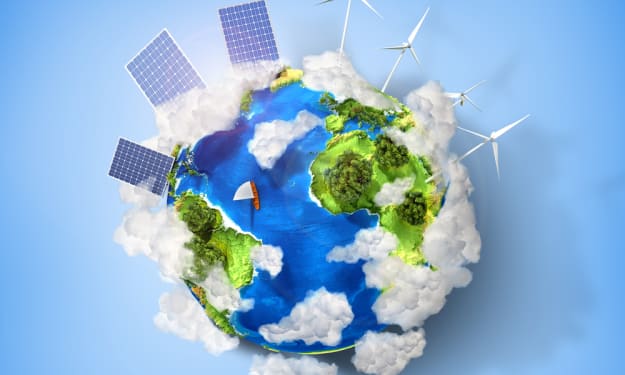Climate Change and Environmental Sustainability
"The Need for Urgent Action: How Climate Change Threatens Sustainability and What We Can Do About It"

What is " Climate Change? "
Climate change refers to long-term shifts in temperature, precipitation, and other aspects of the Earth's climate. It is caused by a variety of factors, but the most significant contributor is human activity, such as the burning of fossil fuels (such as coal, oil, and gas) and deforestation. These activities release greenhouse gases, such as carbon dioxide, into the atmosphere, which trap heat and cause the Earth's temperature to rise. This process is known as the greenhouse effect.
Climate change is a complex and multifaceted issue, and its impacts can be felt in many different ways, such as more frequent and severe heatwaves, storms, and droughts. It can also have serious consequences for ecosystems, wildlife, and human populations, such as the loss of biodiversity, damage to infrastructure, and negative impacts on agriculture and food security.
The Impact of Climate Change on the Environment and Human Populations
Climate change can have a wide range of impacts on the environment and human populations. Some of the most significant impacts include:
•Loss of biodiversity: Climate change can lead to the extinction of certain species that are unable to adapt to changing conditions. It can also disrupt the relationships between species, leading to imbalances in ecosystems.
•Damage to ecosystems: Climate change can alter the distribution and behavior of plants and animals, leading to changes in ecosystems. For example, warmer temperatures may cause certain species to migrate to cooler areas, while others may be unable to survive in their current habitats.
•Negative impacts on agriculture and food security: Climate change can lead to more frequent and severe droughts, heatwaves, and storms, which can damage crops and disrupt food production. It can also lead to changes in the distribution and availability of certain crops.
•Damage to infrastructure: Extreme weather events, such as storms and floods, can cause damage to roads, buildings, and other infrastructure. This can disrupt transportation and essential services, and may lead to long-term economic consequences.
•Displacement of people: Climate change can make certain areas less habitable, leading to the displacement of people. For example, rising sea levels may cause coastal communities to lose their homes and livelihoods.
These are just a few examples of the impacts of climate change. The full extent of these impacts is difficult to predict, but it is clear that they will have significant consequences for the environment and human populations.
The role of Carbon Emissions in Climate Change
Carbon emissions play a central role in climate change. Greenhouse gases, such as carbon dioxide, trap heat in the Earth's atmosphere and cause the planet's temperature to rise. This process is known as the greenhouse effect.
The burning of fossil fuels, such as coal, oil, and gas, is the largest contributor to carbon emissions. Deforestation and land use changes, such as the conversion of forests to agricultural land, also contribute to carbon emissions. When trees and other vegetation are removed, they no longer absorb carbon dioxide from the atmosphere, which can contribute to the greenhouse effect.
Reducing carbon emissions is therefore a key strategy for mitigating the impacts of climate change. This can be achieved through a variety of measures, such as transitioning to renewable energy sources, implementing energy efficiency measures, and protecting forests and other carbon sinks. By reducing the amount of carbon dioxide and other greenhouse gases in the atmosphere, we can slow the rate of climate change and reduce its impacts on the environment and human populations.
" Strategies to reduce Carbon Emissions, such as transitioning to renewable energy sources and implementing energy efficiency measures "
There are many strategies that can be used to reduce carbon emissions and mitigate the impact of climate change. Some examples include:
•Transitioning to renewable energy sources: Renewable energy sources, such as solar, wind, and hydroelectric power, do not produce carbon emissions when they are used. By increasing our reliance on these sources of energy and reducing our reliance on fossil fuels, we can significantly reduce carbon emissions.
•Implementing energy efficiency measures: Energy efficiency measures aim to reduce the amount of energy needed to power homes, buildings, and other infrastructure. This can be achieved through a variety of measures, such as improving insulation, using energy-efficient appliances and lighting, and designing buildings to be more energy-efficient.
•Protecting forests and other carbon sinks: Forests and other natural environments, such as oceans and wetlands, act as "carbon sinks" by absorbing and storing carbon dioxide from the atmosphere. Protecting these environments and planting trees can help to reduce the concentration of carbon dioxide in the atmosphere.
•Implementing carbon pricing: Carbon pricing is a mechanism that puts a price on carbon emissions. This can be achieved through a carbon tax, which is a tax on the carbon content of fuels, or through a cap-and-trade system, which sets a limit on the total amount of carbon emissions and allows companies to buy and sell permits to emit carbon. Carbon pricing can provide an economic incentive for companies to reduce their carbon emissions.
These are just a few examples of strategies that can be used to reduce carbon emissions. There are many other measures that can be taken at the individual, community, and governmental levels to address climate change.
While there are many strategies that can be used to reduce carbon emissions and mitigate the impacts of climate change, there are also a number of challenges and limitations to these efforts. Some of the main challenges include:
•Financial costs: Transitioning to renewable energy sources and implementing energy efficiency measures can be expensive, particularly for governments and companies. This can be a barrier to the adoption of these measures, especially in developing countries or in industries with low profit margins.
•Technological limitations: Some renewable energy sources, such as solar and wind power, are still more expensive than fossil fuels in some cases. In addition, the technology needed to store and distribute renewable energy is not yet fully developed in some cases.
•Political and social resistance: There may be resistance to efforts to reduce carbon emissions from certain groups or individuals who are opposed to changes in energy policies or who stand to lose financially from such changes.
•Limited international cooperation: Climate change is a global problem that requires international cooperation to address. However, there may be differences in the level of commitment to reducing carbon emissions among different countries, which can make it difficult to reach international agreements on climate action.
These challenges and limitations demonstrate the need for a coordinated and well-planned approach to addressing climate change. It will require the efforts of individuals, communities, and governments at all levels to implement the necessary changes and overcome these challenges.
The importance of natural resources, such as forests and oceans, in mitigating the impact of Climate Change
Natural resources, such as forests and oceans, play a vital role in mitigating the impacts of climate change. They act as "carbon sinks," absorbing and storing carbon dioxide from the atmosphere. This can help to reduce the concentration of carbon dioxide in the atmosphere and slow the rate of climate change.
Forests are particularly important carbon sinks, as they absorb and store large amounts of carbon dioxide through the process of photosynthesis. In addition, forests provide a range of other ecosystem services, such as water regulation, soil conservation, and habitat for wildlife. Deforestation, or the removal of forests, can release the carbon stored in trees back into the atmosphere, contributing to the greenhouse effect and accelerating climate change.
Oceans also play a key role in mitigating the impacts of climate change, as they absorb about 30% of the carbon dioxide that is released into the atmosphere. In addition, oceans regulate the Earth's temperature and provide a range of other ecosystem services, such as providing habitat for a wide range of species and supporting the livelihoods of millions of people around the world. However, climate change is also having negative impacts on oceans, such as acidification and the loss of biodiversity. Protecting natural resources, such as forests and oceans, is therefore an important strategy for mitigating the impacts of climate change and promoting environmental sustainability.
" Protecting Natural Resources "
There are many initiatives that can be taken to protect natural resources, such as forests and oceans, and promote environmental sustainability. Some examples include:
•Conservation efforts: Conservation efforts aim to protect natural resources and the species that depend on them. This can be achieved through a variety of measures, such as the creation of protected areas, the implementation of sustainable land use practices, and the restoration of degraded ecosystems.
•Protected areas: Protected areas are areas of land or sea that are set aside for the conservation of nature. These can include national parks, wildlife refuges, and marine protected areas. Protected areas can help to preserve biodiversity and provide a range of ecosystem services.
•Sustainable land use practices: Sustainable land use practices aim to balance the needs of people and the environment. This can be achieved through measures such as the implementation of agroforestry systems, which integrate trees into agricultural landscapes, and the use of sustainable forestry practices, which aim to conserve forests while still allowing for the harvest of timber.
•Restoration of degraded ecosystems: The restoration of degraded ecosystems, such as forests and wetlands, can help to restore the natural functions of these systems and enhance their capacity to absorb and store carbon dioxide.
These are just a few examples of initiatives that can be taken to protect natural resources and promote environmental sustainability. It will require the efforts of individuals, communities, and governments at all levels to implement these measures and ensure the long-term health of our planet.
While there are many initiatives that can be taken to protect natural resources and promote environmental sustainability, there are also a number of challenges and limitations to these efforts. Some of the main challenges include:
•Financial costs: Protecting natural resources and implementing sustainable land use practices can be expensive, particularly for governments and small communities. This can be a barrier to the adoption of these measures, especially in developing countries.
•Limited political will: There may be resistance to efforts to protect natural resources from certain groups or individuals who stand to lose financially from such measures. In addition, the protection of natural resources may not always be a priority for governments and other decision-makers.
•Limited public awareness: Many people may not be aware of the importance of natural resources and the role they play in mitigating the impacts of climate change. This can make it difficult to generate support for conservation efforts and sustainable land use practices.
•Complexity of ecosystems: Ecosystems are complex systems that are often interconnected in ways that are not fully understood. This can make it difficult to predict the full range of impacts that conservation efforts and other initiatives may have on natural resources.
•Limited international cooperation: Natural resources, such as forests and oceans, often cross national boundaries and may require international cooperation to be effectively protected. However, there may be differences in the level of commitment to protecting natural resources among different countries, which can make it difficult to reach international agreements on conservation efforts.
These challenges demonstrate the need for a coordinated and well-planned approach to protecting natural resources and promoting environmental sustainability. It will require the efforts of individuals, communities, and governments at all levels to overcome these challenges and ensure the long-term health of our planet.
"Eventually,
Here are some steps that individuals and governments can take to mitigate and adapt to the effects of climate change:
• Reduce your carbon footprint: There are many steps that individuals can take to reduce their carbon footprint, such as using public transportation or driving a fuel-efficient car, reducing energy consumption at home, and choosing energy-efficient appliances. Planting trees and supporting reforestation efforts can also help to absorb carbon dioxide from the atmosphere.
• Support politicians and policies that address climate change: Governments have a key role to play in addressing climate change and promoting environmental sustainability. Supporting politicians and policies that prioritize climate action can help to create the political will needed to implement the necessary changes.
• Support businesses and organizations that are taking action on climate change: Many businesses and organizations are taking steps to reduce their carbon emissions and promote environmental sustainability. Supporting these efforts, for example by choosing to purchase products from environmentally-conscious companies, can help to drive change at the corporate level.
• Educate yourself and others about climate change: Understanding the causes and impacts of climate change is an important first step in taking action to address it. Educating yourself and others about the issue can help to build support for climate action and raise awareness of the steps that can be taken to mitigate and adapt to the effects of climate change.
By taking these and other actions, individuals and governments can play a key role in addressing climate change and promoting environmental sustainability. It is essential that we take action now to ensure a healthy and prosperous future for ourselves and future generations.
About the Creator
Tuān
A free Soul flying around to find the Motive of Life
Enjoyed the story? Support the Creator.
Subscribe for free to receive all their stories in your feed. You could also pledge your support or give them a one-off tip, letting them know you appreciate their work.





Comments (1)
Good Content We should take responsibility